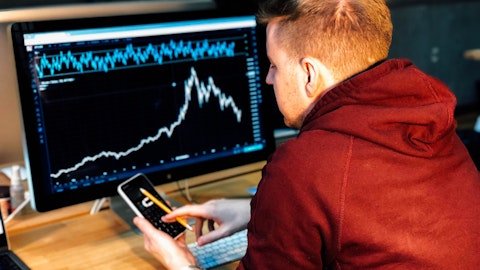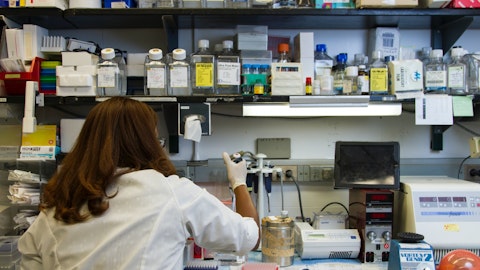Operator: Thank you. Your next question comes from the line of Peter Welford from Jefferies. Please go ahead. Your line is open.
Peter Welford: Hi. Thanks. I have a question on oncology. Just, obviously, there was a lot of emphasis on radioligand therapies, and that was highlighted some of the new and upcoming ones you have as well that are coming through Phase 1/2. There are relatively few other priorities in oncology highlighted within the pipeline. And so I wonder if you could still say, first of all, if you just view on your KRAS and the opportunity there, given also what we’ve seen develop in that market. But also ociperzumab, is that now discontinued, or is it just delayed as you continue to evaluate TIGIT? And so more broadly, is this still an area, which you could see further business development, or do you think this is an arena obviously less focus from Novartis? Thank you.
Vasant Narasimhan: Yeah. Thanks, Peter. So I think on oncology, I mean, it remains a huge focus for the company. 40% of our R&D budget is focused on developing the next wave of oncology medicines. Within solid tumors, in addition to the radioligand therapies, where we have now a growing portfolio across neuroendocrine prostate, we have a range of other indications we’re taking Lutathera into, we have the anti-Integra, the bond basin. We recently are hopefully bringing in a folate as well. So we have a broad portfolio within RLT where we see a significant opportunity. We continue to also pursue the TIGIT through the deal we have with BeiGene, and we have that as an option deal. We also are assessing what other lines of therapy to take that TIGIT into given the competitive landscape, and that’s something we’re actively evaluating.
And then in terms of other active programs that are in Phase 3, certainly the KRAS and the KRAS G12C are continuing. Our overall perspective is a critical thing now is to demonstrate efficacy in a combination setting. We think we’ve seen now from the sales performance of the mono G12C inhibitors. While important for a certain group of patients that have the mutation, much more important is can you ultimately demonstrate tolerability and efficacy of the G12C with a PD-1, with a ship to with other agents. And that’s something that we’re working through to see. And that would really, I think, give us more confidence that this could be a very significant medicine. Now earlier stage within the NIBR portfolio, we have a range of different assets that we’re pursuing.
We have a few targeted protein degradation agents that are advancing now into Phase 1/2, a couple of novel targets in non-small cell lung cancer as well as other solid tumors. So that whole space continues to progress. As you know, oncology has a high level of failure rate. So I don’t want to oversell it, but I think we’re certainly working to continue to find the next wave of solid tumors. And then we are active in the BD&L space. And I think if we could find attractive assets within our core cancers; lung cancer, prostate cancer, the gastric GI cancers, et cetera, those are certainly things we would actively look at. I would say in hematology now between Scemblix, Iptacopan, ianalumab, we have some pretty — building on the legacy, of course, of Gleevec, Tasigna and Promacta/Revolade, we have a pretty good portfolio in hematology.
And then, of course, with now YTB moving into the first-line setting in large B-cell lymphoma, a nice portfolio to continue to keep — maintain our strength in hematology over time. Thanks, Peter. Next question?
Operator: Thank you. Your next question comes from the line of Seamus Fernandez from Guggenheim Securities. Please, go ahead. Your line is open.
Seamus Fernandez: Great. Thanks for the question. So can you maybe just give us a sense of what the team is doing to extend the IL-17 franchise beyond Cosentyx exclusivity in 2029? There’s obviously a number of high-value immunology assets out there in development, we’re just interested to know what Novartis is doing beyond that. And maybe if you could, would you mind commenting on how you see the HS landscape evolving going forward, given some of the data that we’ve seen for bimekizumab and then potential competitor moonlike as well. Thanks so much.
Vasant Narasimhan: Yes. Thanks, Seamus. So first on IL-17A and the Cosentyx portfolio overall, of course, I think we’re actively working on and looking at Cosentyx LOE 2029. We have additional patents that go into the 2030s, which will, of course, actively prosecute as well. We have a range of oral antiimmunological agents we’re pursuing in-house. So oral IL-17A and as well as other oral agents. And of course, actively looking at external opportunities as well in that space, if we see compelling data. So I think that’s going to be really critical for us to look at. But of course, we have time and that’s something we’ll work through over the coming years. I also would say that, in immunology between ianalumab, remibrutinib, as well as other programs we have now advancing through the pipeline, we’re also prepared to pivot not to be — not just focused on psoriasis, PsA and AS, but also try to move into — really be a leader in areas like Sjögren’s, SLE and other immunological illnesses, as you mentioned, like HS.
Now, HS, our view is that, our 52-week data is very compelling. We think this will really be a space where a long-term data is what really matters. We think our 52-week data relative to the TMS are very good. We’re aware of other IL-17A is coming. I think what’s important to note is, this is a very, very undertreated patient population. These patients generally have given up and generally are not coming in for therapy. So the real opportunity here is to get these patients to know that there are better therapies available, and that will create, I think, a large market opportunity, where multiple players can be successful. Given that these agents are looking like they have better efficacy and safety than the anti-TNF . anything to say about other mechanisms at the moment.
In-house are pursuing other mechanisms as well against HS to try to make sure that we cover our bases. We have evaluation of our anti-CD40 ligand. We’re evaluating remibrutinib, our BTK inhibitor. So we have a range of efforts looking at HS, and of course, we’ll see which ones pan out in-house. Next question, operator. And I’ve been advised to really remind everyone, please limit yourself to one question. Appreciate it. Next question, operator.
Operator: Thank you. Your next question comes from the line of Andrew Baum from Citi. Please, go ahead. Your line is open.
Andrew Baum: Thank you. Question is on Pluvicto. Looking at your patient access, Vas, demand clearly materially exceeds supply currently for the product in the US. Could you just outline your confidence of FDA approval for the mid and end year for the new facilities? Just given the recent track record of Leqvio, plus you have a new facility, what is the risk of that dragging on? And connected to that, how should we think about the future competition from Point and Lantheus with their existing isotope in prostate? Thank you.
Vasant Narasimhan: Yeah. I think with respect to the files, we’re ready to file the site and we’re in discussions with FDA to have filed the Millburn site. And the time if we okay to file, there’s a four-month review clock for that additional facility. Our Indianapolis facility with multiple large-scale automated lines, we plan to file in quarter three as well to the NDA. And again, it would be an addition of additional sites. So we would expect a four-month approval time. And so we’re doing everything we can to make that a reality. And we plan right now for those sites, our base plan is for those sites to come online this summer and then later on this year. And then we’d have adequate supply to fully meet the demand of the vision population as well as the PSMAfore population.
Now I think in terms of the competition, it’s important to note this is extremely difficult manufacturing. This is a just-in-time manufacturing that requires really logistics expertise. We currently source the entire US market out of an Italian site and do it successfully. And we believe we’ve built up substantial know-how and expertise with the relevant sites to give us a strong competitive position. Now other players, of course, are going to come in and try to launch a question will be do they have the same scale and expertise that Novartis does to be able to navigate that complexity and really ensure that they can meet the demand. So that’s our outlook right now. We feel good about — by the middle of this year, we’ll be in a very strong position to meet the supply.
I would also note for Leqvio, because I noted your comment on that product, I mean, we have a large-scale line now that’s up and running in Switzerland, which makes us the largest producer of siRNAs in the world. So I think we’re good on gene therapy, RLT and sRNA manufacturing. We feel very good with the approach we’ve taken. And I think we’re in a very good place on all three of them. Next question operator.
Operator: Thank you. Your next question comes from the line of Keyur Parekh from Goldman Sachs. Please go ahead. Your line is open.
Keyur Parekh: Hi. Thank you for taking. One big picture one for you’ve, Vas. With the proposed separation of Sandoz, kind of, Novartis will become a focused innovative medicines company. Once that transaction is done, are you done with the process of changing the shape and structure of Novartis, or do you think there is more, kind of, you want to do relative to the size and the shape of the Innovative Medicines company that will be left at the end of the Sandoz transaction? And just linked with that, I know kind of Ronny Steel has been hiring the higher some people like Dr. Yang, et cetera. But just more broadly, how far along the process of building that kind of growth and strategy functions set under Ronny is kind of Novartis today? When do you think that might be done? Thank you.
Vasant Narasimhan: Yeah. Thanks, Keyur. So broadly speaking, our strategy was to get to become a pure-play innovative medicines company, design the company in the right way. We started that journey in a principled way five years ago. Of course, there was a pandemic for 2.5 years in the middle of that, so it got a little more complex. But I think we have the right set up post the Sandoz spin with a geographic focus on the US and ex-US. And from a commercial standpoint, really committed and renewed leadership in R&D and then the strategy and growth function to really identify external and internal opportunities that can drive the growth. So, I think, post that time period and post seeing through the transformation program we announced last year and the relevant restructuring, I think, we’d be then in a position to really just focus on execution.
We need to execute on our launches, execute on our pipeline, execute on our productivity, continue to generate that mid-single-digit sales growth and that attractive core margin over time. And then, that becomes the core of what we do day-in and day-out, continuing to look at attractive external assets to add on over time. Ronny’s team is getting built out, I think. Off to a strong start. A much more integrated — the most integrated approach now that we’ve had that I’m aware of, at least in 20 years, is the R&D portfolio management, it all falls under one roof now in terms of how we look at the R&D portfolio, an integrated approach to taking commercial input into the earlier stages of research, much more focused on key TAs and being much more disciplined in saying no to projects that are off strategy.
So, I think, all of that’s coming together, it’s been four or five months for Ronny, it’s been two months for Fiona Marshall, but I feel really good that this is a great team that can deliver that innovation horsepower we’re going to need as a pure-play company. Thanks, Keyur. Next question.





